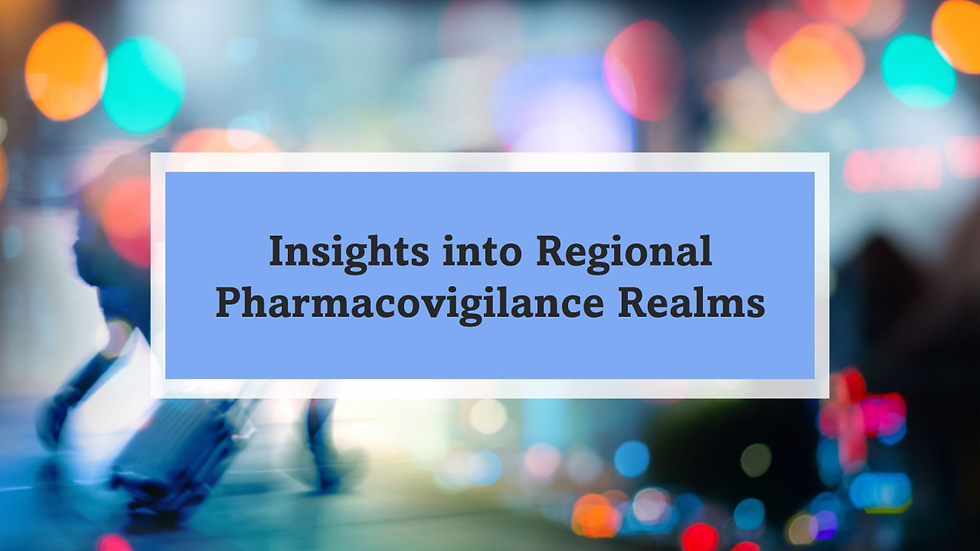
Pharmacovigilance, the science and activities related to the detection, assessment, understanding, and prevention of adverse effects or any other drug-related problems, plays a crucial role in ensuring the safety and efficacy of pharmaceutical products. However, pharmacovigilance regulations vary across different regions, presenting unique challenges and opportunities for pharmaceutical companies operating in global markets. In this blog, we will delve into the regulatory landscape of pharmacovigilance across various regions, exploring key insights and considerations for navigating these complex realms.
Understanding Pharmacovigilance Regulations:
Pharmacovigilance regulations are designed to safeguard public health by ensuring the continuous monitoring and evaluation of the safety profile of medicinal products throughout their lifecycle. These regulations encompass a wide range of activities, including adverse event reporting, signal detection, risk management, and post-marketing surveillance. While the overarching goals of pharmacovigilance regulations are consistent across regions, the specific requirements and implementation vary significantly based on factors such as regional laws, healthcare systems, and cultural considerations.
European Union (EU) Pharmacovigilance Regulations:
The European Union has a comprehensive pharmacovigilance framework governed by the European Medicines Agency (EMA) and implemented through regulations such as Directive 2001/83/EC and Regulation (EC) No 726/2004. The EU pharmacovigilance system includes centralized procedures for marketing authorization, as well as decentralized and mutual recognition procedures. Key components of EU pharmacovigilance regulations include the requirement for marketing authorization holders to have a qualified person responsible for pharmacovigilance (QPPV), the submission of periodic safety update reports (PSURs), and the establishment of risk management plans (RMPs).
United States Pharmacovigilance Regulations:
In the United States, pharmacovigilance regulations are overseen by the Food and Drug Administration (FDA) and are primarily governed by the Federal Food, Drug, and Cosmetic Act (FD&C Act) and Title 21 of the Code of Federal Regulations (CFR). The FDA's pharmacovigilance system includes post-marketing surveillance activities such as adverse event reporting through the Med Watch program, as well as risk evaluation and mitigation strategies (REMS) for certain drugs with known safety concerns. Pharmaceutical companies operating in the U.S. must comply with stringent reporting requirements and adhere to Good Pharmacovigilance Practices (GVP) to ensure compliance with regulatory standards.
International Council for Harmonization (ICH) Guidelines:
The International Council for Harmonization (ICH) plays a critical role in promoting global harmonization of pharmacovigilance regulations through the development of guidelines and standards accepted by regulatory authorities worldwide. The ICH has issued several guidelines related to pharmacovigilance, including the ICH E2E Pharmacovigilance Planning guideline, which outlines principles for developing pharmacovigilance plans, and the ICH E2C(R2) Periodic Benefit-Risk Evaluation Report (PBRER) guideline, which provides guidance on the preparation of periodic safety update reports.
Challenges and Considerations:
Navigating the complex landscape of pharmacovigilance regulations poses several challenges for pharmaceutical companies, including compliance with varying requirements across regions, ensuring timely and accurate reporting of adverse events, and managing the increasing volume of safety data generated during drug development and post-marketing surveillance. Additionally, cultural differences, language barriers, and differences in healthcare infrastructure can impact the implementation of pharmacovigilance activities in different regions.
Best Practices for Global Pharmacovigilance:
To navigate the diverse regulatory landscape of pharmacovigilance effectively, pharmaceutical companies should adopt a proactive and strategic approach. This includes establishing robust pharmacovigilance systems and processes, investing in training and education for staff involved in pharmacovigilance activities, leveraging technology and automation to streamline data collection and analysis, and fostering collaboration and communication with regulatory authorities and other stakeholders.
Conclusion:
Pharmacovigilance regulations play a crucial role in ensuring the safety and efficacy of pharmaceutical products and protecting public health. As pharmaceutical companies operate in increasingly globalized markets, understanding and navigating the diverse regulatory landscape of pharmacovigilance across different regions is essential. By staying informed about regional regulations, adopting best practices for global pharmacovigilance, and embracing a culture of compliance and continuous improvement, pharmaceutical companies can effectively manage the complexities of pharmacovigilance and contribute to the safe and responsible use of medicinal products worldwide.
Learn more about Crypta and discover how your organization can transition to a Literature Review Software that supports Global and Local Literature Review. Ready to see it in action? Request a demo today.

Kommentare